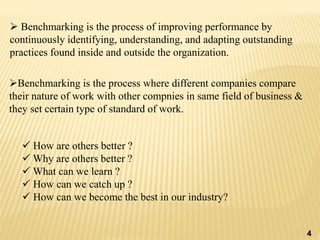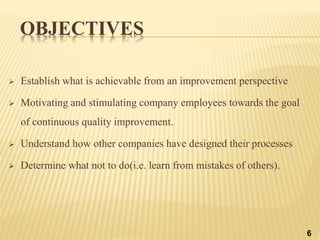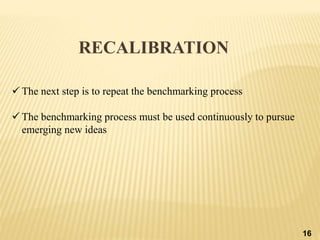Benchmarking
- 1. BENCHMARKING Presented by- Ashish R Chaudhari M. Pharm 1st year Quality Assurance 1
- 2. Benchmarking Meaning Benchmarking Definition Benchmarking Objectives Why Benchmarking? Benchmarking Types Benchmarking Process Advantages & Disadvantages Limitations Conclusion Reference 2 CONTENT
- 3. WHAT IS BENCHMARKING? ‘’ Improving Ourseleves By Learning From Others’’ 3
- 4. Benchmarking is the process of improving performance by continuously identifying, understanding, and adapting outstanding practices found inside and outside the organization. Benchmarking is the process where different companies compare their nature of work with other compnies in same field of business & they set certain type of standard of work. How are others better ? Why are others better ? What can we learn ? How can we catch up ? How can we become the best in our industry? 4
- 5. The formal definition of benchmarking is “The continuous process of measuring products, services, and practices against the company’s toughest competitors or those companies renowned as industry leaders”. 5
- 6. OBJECTIVES Establish what is achievable from an improvement perspective Motivating and stimulating company employees towards the goal of continuous quality improvement. Understand how other companies have designed their processes Determine what not to do(i.e. learn from mistakes of others). 6
- 8. WHY BENCHMARKING? Benchmarking is a more efficient way to make improvements. Managers can eliminate trials and errors. Benchmarking speeds up organization’s ability to make improvements. Today, time is of the essence. Benchmarking has the ability to bring your performance up as a whole significantly. Learn from others’ experiences. Set realistic but ambitious targets 8
- 9. What” is being compared with other organizations Who” is being compared with our organization V/S On the basis of “What” is being compared with other organizations and “Who” is being compared with our organization, we can classify benchmarking. 9 TYPES OF BENCHMARKING
- 10. On the basis of “What” is being compared with other organizations we have four main types. These four major types of benchmarking are evolutionary beginning with product, through to functional (performance), process and strategic benchmarking. Product Performance Process Strategic 10
- 11. On the basis of “Who” is being compared with our organization, we have these categories External vs internal Generic International Best in Class 11
- 13. PLANNING • During this phase the organization determines which process to benchmark and against what type of organization. • Select the process • Form Team • Understand & document process • Establish performance measure 13
- 14. ANALYSIS Sort information & data Quality control information & data Normalise data if necessary Identify gaps in performance Level Identify causes for gaps Following data acquisition, an analysis is performed for the performance gap between the source organization and the recipient organization. An indication of best practice is then evident. 14
- 15. INTERPRETATION Two groups must agree on the change • Process owners (those who run the process) • Upper Management (incorporating changes and providing resources) Communicate Benchmark findings and recommendation and get approval. Establish Functional Goals ACTION Specify tasks Sequence tasks Determine resource needs Establish task schedule Assign responsibility for each task Describe expected results Specify methods for monitoring results 15
- 16. The next step is to repeat the benchmarking process The benchmarking process must be used continuously to pursue emerging new ideas 16 RECALIBRATION
- 17. ADVANTAGES • Helps organisations understand strengths and weaknesses. • Helps better satisfy the customer’s needs by establishing new standards and goals. • Motivates employees to reach new standards and to be keen on new developments. • Helps organisations improve their competitive advantage. • Is a cost-effective and time-efficient way of establishing a pool of innovative ideas. 17
- 18. • Incorrect comparisons • Lack of information • Lack of understanding • Copying others • What is best for someone else may not suit you • Poorly defined benchmarks may lead to wasted effort and meaningless results. DISADVANTAGES 18
- 19. LIMITATION TO BENCHMARKING Benchmarking is a tough process that needs a lot of commitment to succeed. Benchmarking should be a continues process as the competition is always changing. Selection and empowerment of benchmarking teams. The adaptability of the practices should be tested and the implementation results should be verified. 19
- 20. 20 Benchmarking vital tool in maintaing world class status. Improving ourseleves by learning from others. Benchmarking is a practice of being humble enough to admit that someone else is better than something & beingwise enough to learn how to match them & even supress them at it. Conclusion
- 21. REFERENCES 1. Implementing Juran’s Road Map For Quality Leadership: Benchmarks And Results, By Al Endres, Wiley, 2000 Pg No-12.1 2. Camp, Robert C.(1994). Business Process Benchmarking : Finding And Implementing Best Practices , ASQC Quality Press, Milwaukee. 3. M. R. & Amin, N. A. (2003). Benchmarking Learning Outcomes Of Undergraduate Business Education Benchmarking: An International Journal, 10(6), 538-558. 21
- 22. 22 THANK YOU





















